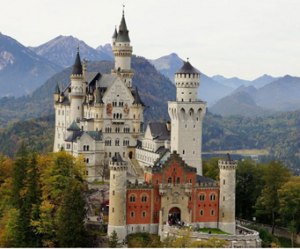Increasing sales through cultural brands? – NEUSCHWANSTEIN
The case: There are many distinctive cultural brands, recognisable the world over. Neuschwanstein, for example – the world-famous castle of King Ludwig II of Bavaria.

Its name – Der Stein vom neuen Schwan [the stone of the new swan] – expresses Ludwig’s affinity with Richard Wagner, in whose opera Lohengrin, the swan knight Lohengrin appears on a barge pulled by a silver swan.
In 2005, in order to prevent the sale and dilution of this cultural asset, the Free State of Bavaria, which owns the castle, registered a German trade mark for it.
![]()
The brand covers a number of goods and services. The trade mark was to be used only by licensees whose goods and services were ‘of high quality, mindful of the cultural mission’ and ‘reflect[ed] Bavarian culture’.
However, the Bundesverband Souvenir – Geschenke – Ehrenpreise e.V. (Federal Association for Souvenirs, Gifts and Honorary Awards) felt that this could jeopardise the sales of many of its members and applied for the trade mark to be declared invalid.
The German Federal Supreme Court ruled in favour of the association in 2012, on the basis that the public would not see the trademark as a product identifier. The goods were typically sold as travel souvenirs or accessories. On them, the only function of the name NEUSCHWANSTEIN was to designate the place of interest. The mark was devoid of any distinctive character, and so NEUSCHWANSTEIN was largely cancelled, except for Pharmaceuticals, Insurance, Financial and monetary services, Real estate services, Telecommunication services, Transport, Packaging and storage of goods, Farming and Forestry services.
However, in 2011, the Free State of Bavaria also registered the name NEUSCHWANSTEIN as a Community trade mark.
The Bundesverband Souvenir – Geschenke – Ehrenpreise e. V. (Federal Association for Souvenirs, Gifts and Honorary Awards) has now also taken action against this, referring to the decision of the Federal Court of Justice. It argued that in the case of souvenirs, ‘Neuschwanstein’ is perceived only as a descriptive reference to the place where the goods are offered. Therefore, the mark also lacks distinctiveness.
Was that right?
The souvenir function does not constitute a characteristic of goods and services. It is merely an aspect of marketing. A mug is a mug, even if it is sold as a souvenir. And the word ‘Neuschwanstein’ itself says nothing about the characteristics of the goods and services, nor does it describe them. The public will not reasonably perceive NEUSCHWANSTEIN as a descriptive indication of the place of sale. The castle is known not because of the souvenirs sold or the services provided there, but because of its architectural uniqueness.
NEUSCHWANSTEIN is therefore not descriptive in the opinion of the ECJ. Although it appears on souvenirs, it does not describe them. It is neither an advertising medium nor an advertising slogan. The absolute ground on the basis of a possible descriptive effect which may serve, in trade, to designate the characteristics of the goods or service (Article 7(1)(c) of Regulation No 2017/1001) has been rejected.
The Court did not have to decide whether the word NEUSCHWANSTEIN lacked the necessary distinctive character for other reasons, because it would be understood only as such and not as a means of distinction (Article 7(1)(b) of Regulation No 2017/1001). However, the lower courts had also rejected this absolute ground for refusal.
The earlier decision of the German Federal Court of Justice to the contrary was not relevant to the assessment of the EU trade mark. The EU trade mark is based on an autonomous trade mark system which is independent of any national system.
Consequently, the application for a declaration of invalidity of the EU trade mark NEUSCHWANSTEIN was dismissed,
Court of Justice of the European Union, 6 September 2018, C 488/16 P.
Learnings: The Court’s decision shows that companies can benefit from the attractiveness inherent in the cultural branding of their products. Accordingly, the mark ‘WINDSOR CASTLE’ was accepted as an EU trade mark for an array of products, as it does not contain any specific references to the goods concerned or their characteristics. In contrast, however, the German Federal Patent Court rejected the German trademark application “KÖLNER DOM” [Cologne Cathedral] in January 2023 in line with the German Federal Supreme Court. The public would only see a motif-like reference to the well-known landmark, but not an indication of origin. Nevertheless, the court allowed an appeal to the BGH. Its decision is now eagerly awaited.